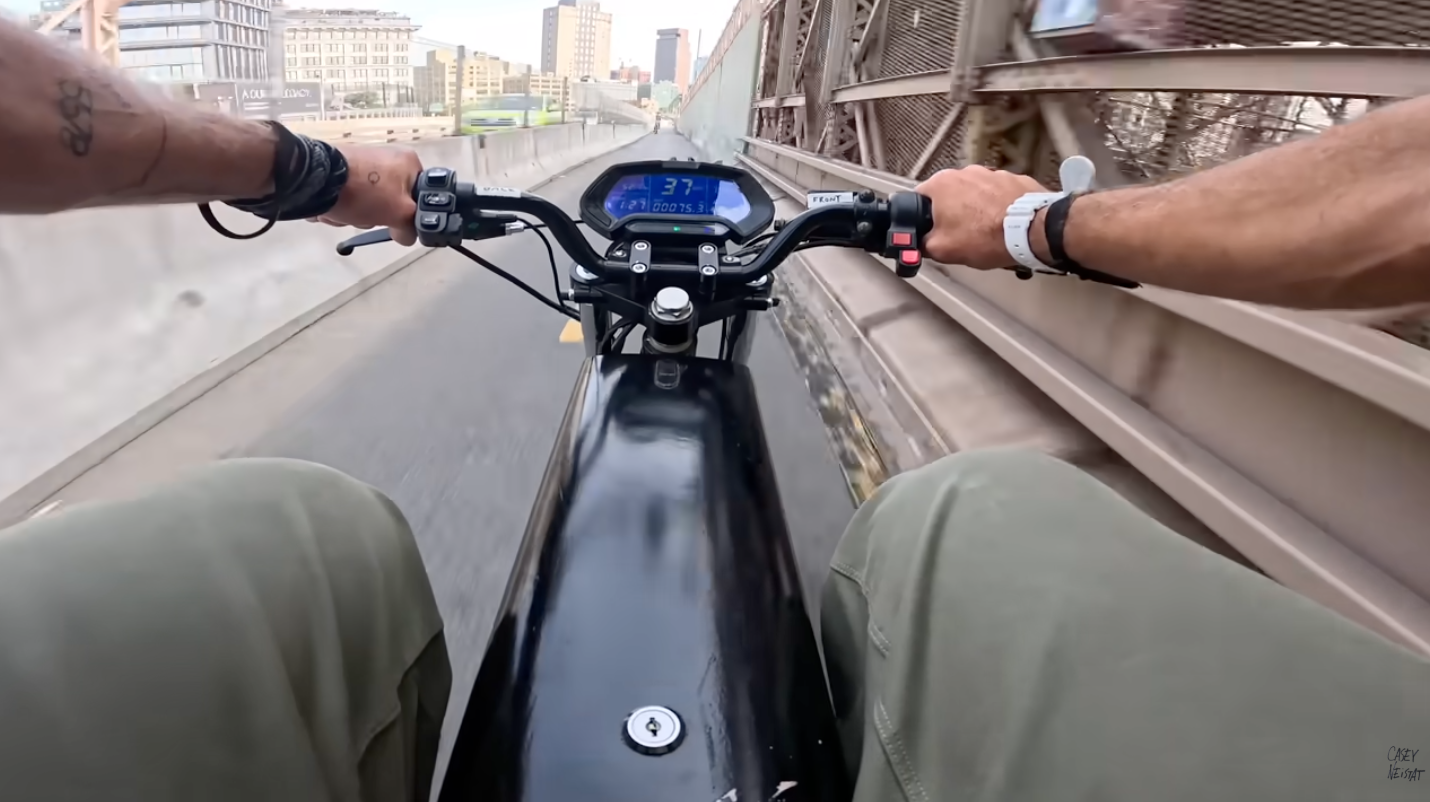They’re faster than Johnny Law.
It’s illegal to operate an electric bike that can exceed 25 miles per hour in this city, but that doesn’t stop online retailers from selling the illegal “e-bikes” nor has it stopped New Yorkers from buying these vehicles and riding them in the city’s bike lanes at high speed.
At its worst — like in last week’s horrific fatal crash on Flushing Avenue — pedestrians and cyclists are injured or killed. Setting aside that car drivers cause virtually all the injuries and deaths on our streets, every time there is rare crash involving an illegal e-bike, naysayers capitalize by conflating them with safe, legal e-bikes to further an anti-bike agenda.
And Mayor Adams has added to the confusion, launching a criminal crackdown on legal e-bikes that has ensnared all kinds of cyclists, as Streetsblog has documented. Experts have argued that the Trump-friendly administration has used the notion of e-bike “chaos” to justify a crackdown that allows the NYPD to target the mostly immigrant delivery work force.
But the main confusion right now comes from vehicles that look like bikes, are operated like mopeds, but can reach motorcycle speeds.
Take the killing of Terri Valenti on Oct. 6. The Queens resident had stepped off an MTA bus at a Brooklyn Navy Yard stop that just happens to be a shared space with the Flushing Avenue bike lane. The design is confusing for pedestrians and cyclists alike, but speed also played a factor: the e-bike rider who hit Valenti was using an illegal Movcan V30 — which is marketed on the company website as an “e-bike” with a maximum speed of 32 miles per hour.
In other words, it’s not an e-bike at all. Under state law, it’s an illegal motorized scooter.
Confusing definitions
Lots of motorized vehicles look like e-bikes and are advertised as “e-bikes.” But they are illegal to buy and sell in New York City and are classified in New York State law as “motorized scooters,” a catch-all phrase for any motorized vehicle that cannot be registered by the Department of Motor Vehicles or is not specifically legal (such as legal e-bikes and stand-up scooters).
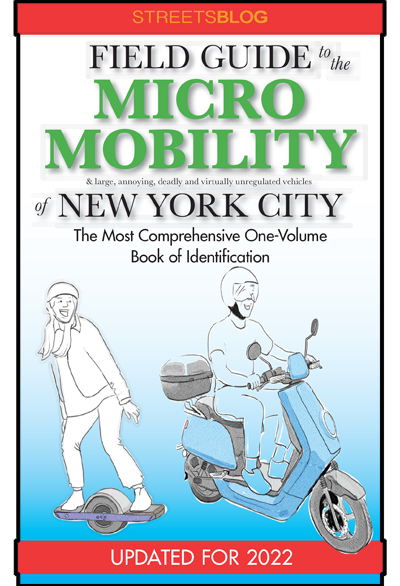 The Streetsblog Field Guide — as relevant today as when it was published.Click to read
The Streetsblog Field Guide — as relevant today as when it was published.Click to read
Streetsblog has been clarifying the situation since e-bikes were legalized by then-Gov. Andrew Cuomo during the initial boom in food and grocery delivery in 2020. We published a “Field Guide to Micromobility” from 2021, and we’ve published the definitions of the three classes of legal e-bikes dozens of times, but they bear repeating:
Class 1: These are “pedal assist” e-bike without a motorcycle-like throttle. They cannot legally exceed 20 miles per hour. Electric Citi Bikes are Class 1.Class 2: These bikes have a throttle, but also cannot exceed 20 miles per hour.Class 3: These are the same as Class 2, but can go up to 25 miles per hour. They are only legal in New York City (though a pending City Council bill would eliminate them, a bill that Transportation Alternatives supports).
None of these bikes can have a motor exceeding 750 watts.
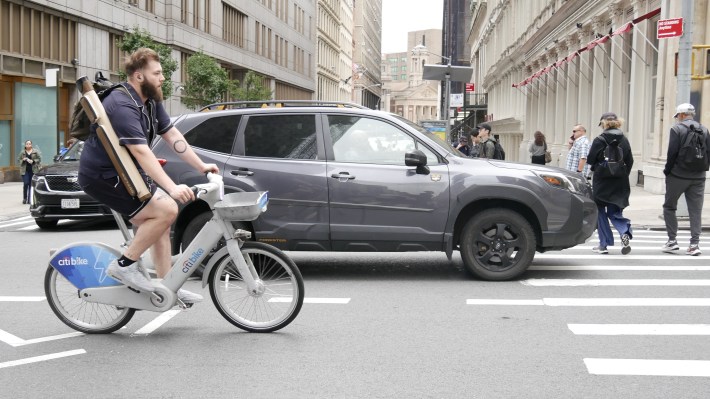 A Citi Bike e-bike is Class 1.Photo: Sophia Lebowitz
A Citi Bike e-bike is Class 1.Photo: Sophia Lebowitz
Those definitions are clear, yet confusion remains, allowing companies to throw around the term “e-bike” when they sell heavy, fast, illegal vehicles like the one Valenti’s killer was riding.
“The whole way that this all unfolded is classic New York,” said Jon Orcutt, a former Department of Transportation official and advocacy director with Bike New York. “[Cuomo] took the lid off in 2020 without any real preparation and it just exploded.”
How is this happening?
Often, online retailers hawk bikes with multiple modes, an “eco-mode” or a “city-mode” to use on the street and a faster “off-road-mode” or “speed-mode,” that allow riders to switch to higher speeds and race through the city at more than 30 miles per hour, endangering other cyclists and pedestrians.
The website of one city store, Last Mile, sells numerous “e-bikes” that are not e-bikes but illegal motorized scooters.
The Ultra Urban – Zooz Electric BMX, for example, is advertised as “the pinnacle of Class 2 e-bike experiences.” But the machine is not Class 2 because it is “capable of reaching speeds of up to 34 miles per hour on closed courses.”
That reference to “closed courses” is a common dog-whistle. The Xyber Electric Bike, for instance, can hit “a top speed of 35 mph for off-road adventures.” Or on: The Segway-made device connects to an app where the rider can switch between modes seamlessly.
And of course, New Yorkers are ordering these vehicles right to their front doors.
One such New Yorker, the YouTuber Mr. E, recently posted an unboxing video of a Luckeep M5 “e-bike” with the title HIGH SPEED RIGHT OUT THE BOX THE PERFECT E-BIKE THE LUCKEEP M5 MAX. Luckeep’s website advertises that the bike has a 2,000-watt motor and can reach speeds of over 37 miles per hour with the throttle.
It’s not street-legal, but Luckeep has would-be buyers confused: “Regulations vary by location,” the company says on its website. “The M5 Max is categorized as a moped-style electric bike, so in most areas, you may not need a license. However, we recommend checking local e-bike laws to ensure compliance.”
The online retailer Ride1Up makes other self proclaimed “moped style” e-bikes, and boasts a “multi class” speed system where riders can program the bike to be either “Class 2, Class 3, and ‘Off-Road’ mode which unlocks speeds of 28+ MPH for private road use only.”
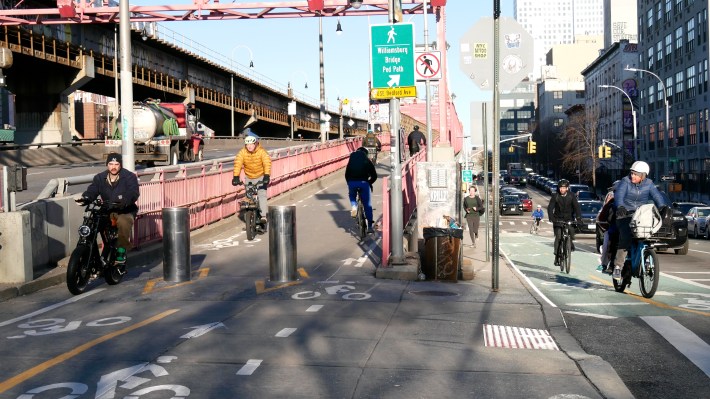 Count ’em! Three e-bike riders cross paths on the Williamsburg Bridge.Photo: Sophia Lebowitz
Count ’em! Three e-bike riders cross paths on the Williamsburg Bridge.Photo: Sophia Lebowitz
Another brand, Onyx, sells a 155-pound “bike” that popular YouTuber Casey Neistat rode at 40 miles per hour on the narrow Brooklyn Bridge bike path. Onyx also sells “bikes” with a 65-mile-per-hour sport mode. The company says all of its modes over 20 miles per hour are for “off-road use only,” but as Neistat shows in his video, that doesn’t stop people from taking them in bike lanes.
Another brand, SUPER73, recently changed its bikes in response to a California speed-limit law that put an end to the company’s 30-mph mode-switching feature in its app. But customers get around this by downloading third-party apps, according to the r/super73 subreddit, which has almost 6,000 weekly visitors.
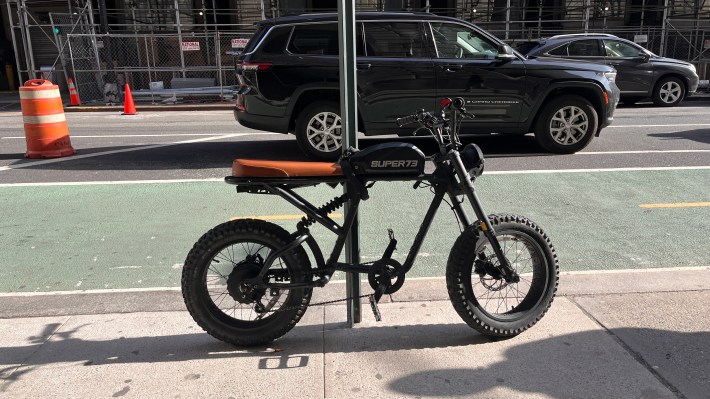 A SUPER73 e-bike parked in Lower Manhattan. Photo: Sophia Lebowitz
A SUPER73 e-bike parked in Lower Manhattan. Photo: Sophia Lebowitz
“Those bikes are ‘off-road’ vehicles, but they have ‘eco’-mode so people ride them on the street anyway,” said Kyshon Byam, the general manager of Greenpath Electric Bikes, which sells legal e-bikes in South Slope. “Because they’re not road legal, I don’t keep any in the store. But some of the brands I deal with make them. But it’s like buying a[n illegal] dirt bike. You can always buy a dirt bike in the city, and cart it off somewhere. So it’s the same idea.”
Last Mile and Mr. E did not respond to Streetsblog’s questions for this story.
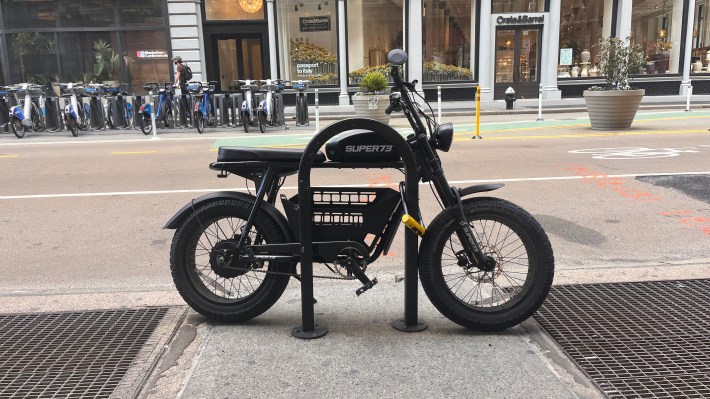 This “bike” is illegal. Yet when Streetsblog tried to report it to 311, we discovered there is no category for reporting illegal motor bikes.Photo: Sophia LebowitzWhat can be done?
This “bike” is illegal. Yet when Streetsblog tried to report it to 311, we discovered there is no category for reporting illegal motor bikes.Photo: Sophia LebowitzWhat can be done?
On-street enforcement falls to the NYPD, but officers are not well trained in recognizing various modes and cops are often confused because top brass jumble the messaging. That’s why advocates push for point-of-sale regulation.
“It’s a huge lift to say that cops are going to be trained to even recognize [illegal] motorized bikes,” said Steve Vaccaro, a lawyer who represents crash victims. “The idea of [getting pulled over and] saying, ‘But officer, I had it in “city” mode, not in “off-road” mode,’ that’s disingenuous. The city has a right to strictly limit the technology that’s going to be used in public space if there’s evidence to show that it causes harm.”
But some also want to see the NYPD do more to confiscate blatantly illegal devices to send a message and improve safety.
“[The city] could do more to just start chipping away at this, but you’ve got to talk about it and do it visibly, or it doesn’t work. … The parks are one place to start, because it’s where it drives people crazy to see that kind of behavior,” said Orcutt.
Enforcement against the sale and use of illegal motorized scooters is split between the NYPD and the Department of Consumer and Worker Protection.
Since September 2023, DCWP has issued more than 70 summonses to businesses illegally selling or renting motorized scooters at physical stores throughout the city, a spokesperson told Streetsblog.
The NYPD, which confiscates illegal e-bikes and mopeds as a part of its “quality-of-life” initiative, said its efforts to curb illegal motorized scooter have been successful, citing a decline in seizures as proof that retailers are following the rules.
From November 2021 to the end of 2022, during a period of intense competition in the illegal moped industry, the NYPD checked 32 retailers across the city, seizing 158 illegal motorized scooters and issuing cease-and-desist letters. In 2023, the department inspected 89 additional stores, seizing just 27 illegal bikes. In 2024, 263 locations were searched but only 11 scooters were seized, a “significant rise in retailer compliance,” said an agency spokesperson, who declined to provide a name.
Through September of this year, the NYPD has conducted just two follow-up inspections and seized four bikes.
Recommended
But neither agency is stopping online retailers from selling these bikes. And the NYPD declined to provide numbers on how many illegal motorized scooters it has seized from individuals, not retailers. One ride over the Williamsburg Bridge will confirm, people are still getting these bikes.
New York exceptionalism
It’s one thing for companies to hawk blatantly illegal vehicles to masquerade as bikes, but making matters worse is the fact that New York State’s class definitions differ from regulations throughout the world, or the country, even though e-bike manufacturing is a global business.
Under federal regulations, Class 3 e-bikes can top out at 28 miles per hour with pedal assist, not the throttle, and are classified as motor vehicles. This is the source of lots of the current confusion. E-bike manufacturers that create bikes for a national or international market make Class 3 bikes that go up to the national threshold, not New York City’s (25 miles per hour), which is unique to the Big Apple.
“You end up with a bike that has this top speed of 28 miles per hour,” said Vaccaro. “A lot of the manufacturers have become wise to this, and they hide the top speed specs. I’ve spent my time talking to manufacturers saying, ‘What’s the top speed?’ And they’re fuzzy.”
And this can have legal repercussions. E-bike riders who purchase a Class 3 bike under federal guidelines can’t ride them legally under New York City law. So in the event of a crash, injured riders or their victims are not eligible for city resources that, for instance, cover uninsured drivers, or drivers who flee the scene.
“If you were operating a two-wheeled electric powered conveyance in New York City with a top speed of 28 miles an hour, and you don’t have insurance of your own, you are operating an unlawfully uninsured motor vehicle,” said Vaccaro. “New York City has a scheme for providing for medical treatment and compensation for individuals harmed by an unidentified or uninsured driver. But that scheme is made explicitly of no help to individuals who are operating an unlawfully uninsured motor vehicle.”
A recently introduced bill by Council Member Crystal Hudson (D-Crown Heights), would eliminate the Class 3 category for e-bikes in New York City. If it passes, Intro 1380 would at least end the confusion that has allowed manufacturers to sell in New York e-bikes for the national market that have 28-mile-per-hour top speeds.
The bill has the support of 22 Council members, Los Deliveristas Unidos and Transportation Alternatives.

